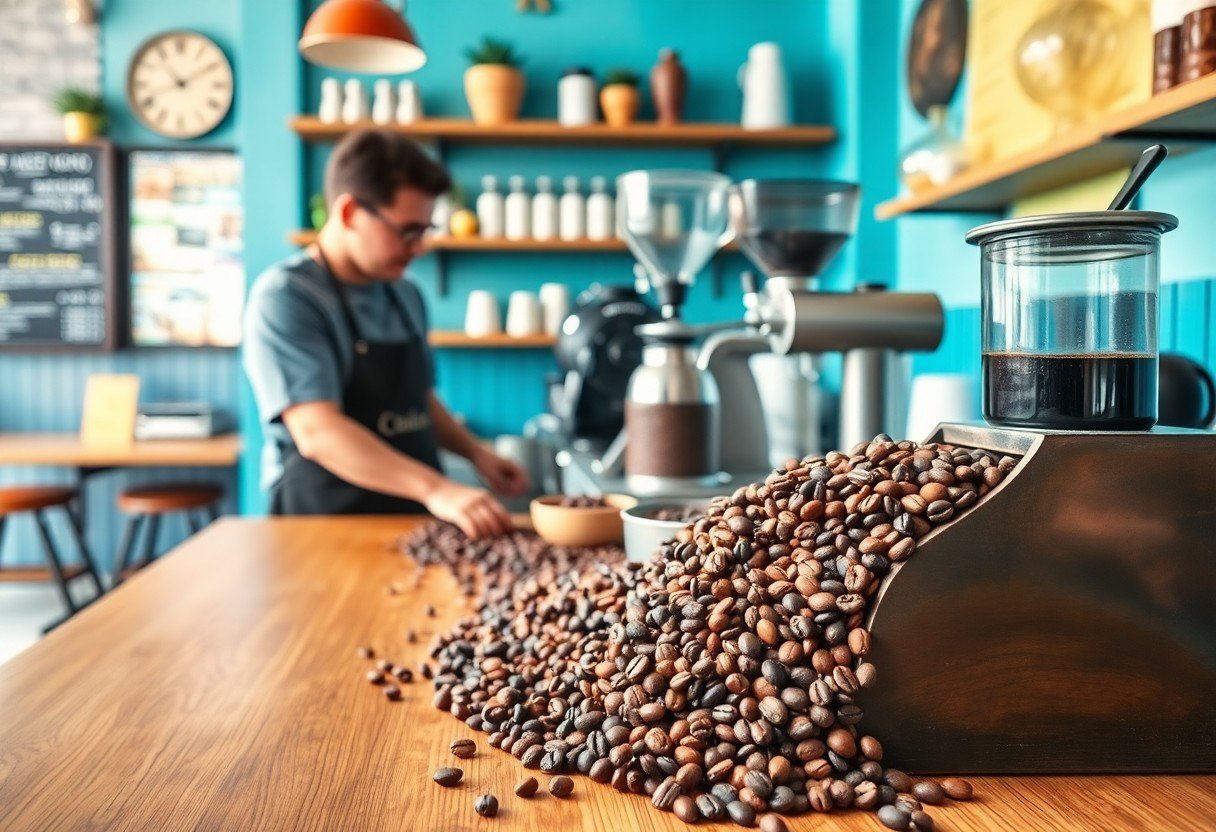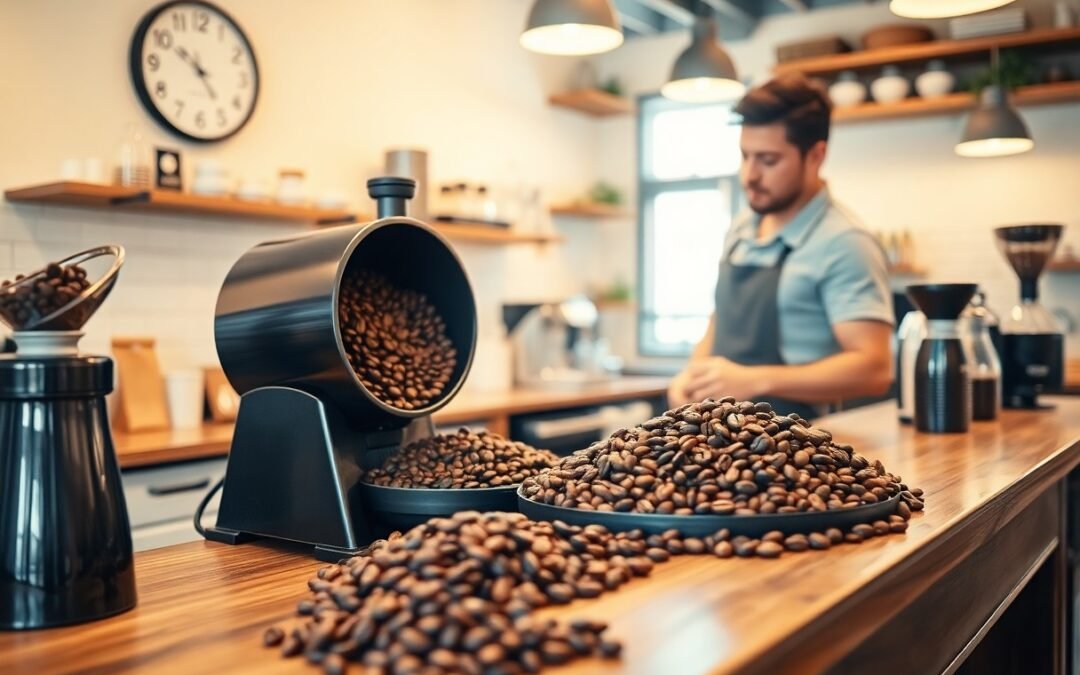Most coffee enthusiasts seek ways to enhance their brewing process, and self-roasting is a powerful method to achieve that. By roasting your own beans, you gain control over the flavors, aromas, and characteristics that define your cup of coffee. This hands-on approach not only allows you to experiment with different roast levels but also deepens your appreciation for the intricate journey from green bean to perfect brew. In this post, you will discover how self-roasting can transform your specialty coffee experience into something uniquely yours.
Understanding Self-Roasting
To truly appreciate the nuances of specialty coffee, self-roasting can play a transformative role in your experience. By experimenting with different roast profiles, you can unlock unique flavors and aromas that commercial roasters may not offer. Explore this concept further by checking out Elevating Your Coffee Experience with a Coffee Subscription.
The Science of Coffee Roasting
By understanding the science behind coffee roasting, you can better appreciate the transformation that occurs during the roasting process. Heat applied to the green coffee beans triggers a series of chemical reactions, known as the Maillard reaction and caramelization, which create the distinct flavors and aromas associated with your favorite brews.
Benefits of Self-Roasting
One major advantage of self-roasting is the full control you gain over the process, allowing you to tailor the roast to your preferences. This customization leads to a fresher and more flavorful cup of coffee, and you can experiment with different beans and roast levels until you find your perfect combination.
Self-roasting opens the door to exploration within the world of coffee, enabling you to engage directly with the flavors and profiles that speak to you. You’ll develop a deeper connection with each cup as you fine-tune your roasting technique and embrace the freshness that comes from roasting at home. This hands-on experience not only adds layers of enjoyment but also transforms your daily coffee ritual into an art form.

Choosing the Right Coffee Beans
Assuming you want to elevate your coffee experience, selecting the right beans is crucial. Specialty coffee beans can provide an exceptional flavor profile, allowing you to explore various tastes and aromas. By understanding the importance of sourcing quality beans, you’ll discover that the journey begins with making informed choices. For insights on the benefits of choosing your own beans, check out Why You Need to Try Roasting Your Own Coffee Beans.
Selecting Specialty Coffee Varieties
Coffee varieties play a significant role in your overall tasting experience. Each type boasts unique flavor notes influenced by its origin, climate, and processing method. Exploring different varieties will open up a world of distinct characteristics, enabling you to find your favorite profiles.
Sourcing Quality Green Beans
Right from the start, sourcing high-quality green beans will shape your roasting success. Ensure you choose beans that have been ethically sourced and properly stored, as this impacts flavor and aroma. By selecting beans from reputable suppliers or local roasters, you set a solid foundation for your self-roasting adventure.
Considering the source of your green beans can significantly enhance your coffee quality. Look for farmer cooperatives or direct trade options that promote sustainability and fair practices. This will not only support coffee-growing communities but also ensure you receive fresher, higher-quality beans. Engaging with suppliers who provide information about their beans’ origins allows you to connect with your coffee on a deeper level and enhances the overall roasting and brewing journey.
The Self-Roasting Process
The self-roasting process allows you to bring out the unique flavors and qualities of your specialty coffee beans. By controlling the roasting conditions, such as time and temperature, you can tailor the roast to your taste preferences, resulting in a truly personalized coffee experience. It opens up the opportunity to explore various roasting styles, enhancing both the aroma and flavor of your brews.
Equipment and Tools Needed
Process your roasting journey by acquiring important equipment and tools. An effective roasting setup includes a coffee roaster, green coffee beans, a thermometer, and a scale for measuring bean quantities. Additional items like a cooling tray and a timer will further streamline your process, allowing you to accurately achieve your desired roast profile.
Step-by-Step Roasting Guide
Any successful self-roasting venture requires following a structured guide. The table below provides a clear step-by-step process to ensure your beans are roasted to perfection:
| Step | Description |
| 1. Preheat Roaster | Set your roaster to the desired temperature. |
| 2. Add Beans | Measure and add your green coffee beans. |
| 3. Monitor Roast | Observe color change and listen for first and second cracks. |
| 4. Cooling | Quickly cool the beans to stop the roasting process. |
| 5. Resting | Allow beans to rest for 12-24 hours before brewing. |
Further customization of your roasting experience can be achieved by understanding each step in detail. The table below outlines key aspects to consider that will enhance your roasting skills:
| Aspect | Influence on Flavor |
| Temperature | Affects the Maillard reaction and caramelization. |
| Time | Determines roast level, impacting acidity and body. |
| Airflow | Affects evenness of roast and flavor clarity. |
| Bean Origin | Provides unique characteristics and flavor profiles. |
Flavor Profiling and Experimentation
Keep in mind that self-roasting allows you to explore a vast spectrum of flavors that are often overlooked in commercial coffee. By experimenting with different bean origins, roast levels, and brewing methods, you can uncover unique taste profiles that cater to your personal preferences. This hands-on approach not only enhances your coffee experience but also deepens your appreciation for the complexity behind each cup.
Understanding Roast Levels
Flavor is significantly influenced by roast levels, which range from light to dark. Each level highlights different flavor notes, acidity, and body. Light roasts tend to emphasize fruity and floral characteristics, while darker roasts provide deeper, chocolatey, or smoky flavors. By understanding these profiles, you can select the perfect roast to suit your taste.
Enhancing Flavor Through Technique
For optimal flavor extraction, the roasting technique you employ plays a pivotal role. Different methods can accentuate or suppress certain flavor notes, allowing you to tailor your coffee experience. Techniques such as controlling the airflow, temperature adjustments, and even the timing of the roast can impact the final taste profile.
In fact, minor tweaks in your roasting technique can yield remarkable differences in flavor. For example, experimenting with longer roast times may enhance caramelization, bringing out sweetness, while adjusting temperature can unlock brighter acidity or bolder bitterness. By carefully adjusting these variables, you’ll refine your ability to craft a cup of coffee that perfectly aligns with your unique taste preferences.
Storing and Brewing Your Roasted Coffee
Many coffee enthusiasts find that the way they store and brew their freshly roasted beans can significantly enhance their overall experience. Proper methods can preserve the intricate flavors and aroma you worked hard to achieve during the roasting process. To relish your coffee’s true potential, it’s necessary to pay attention to these key aspects of handling your roasted beans.
Proper Storage Methods
An ideal storage environment for your coffee beans should be cool, dry, and dark. Use an airtight container, preferably made of glass or ceramic, to prevent moisture and air exposure. This helps maintain the beans’ freshness, allowing you to enjoy their vibrant flavors longer.
Brewing Techniques for Fresh Coffee
Your brewing technique plays a vital role in extracting the best flavors from your freshly roasted coffee. Choosing the right grind size, water temperature, and brewing time can significantly influence the taste profile of your cup.
Coffee brewing is all about balance. Aim for a medium grind for methods like pour-over and French press, while espresso requires a fine grind. Use filtered water heated to around 195°F to 205°F for optimal extraction. Experimenting with brewing times will help you find that sweet spot—typically between 3 to 5 minutes for most methods. Ultimately, fine-tuning these variables allows you to enjoy the unique characteristics of your home-roasted coffee. Let your palate guide you to the ideal cup each time!
Community and Resources
After venturing into self-roasting, you will find a vibrant community that shares your passion for specialty coffee. Engaging with fellow enthusiasts not only enhances your skills but also opens doors to new methods, recipes, and insights. Moreover, many resources, such as online forums and local roasters, are available to help guide your journey and connect you with like-minded individuals.
Engaging with Coffee Roasting Communities
Below the surface of self-roasting, a plethora of coffee roasting communities exist, both online and offline. You can participate in discussion forums, join social media groups, or attend local meetups, where you can exchange tips, techniques, and experiences. Engaging with these communities will allow you to gain broader perspectives on your roasting practices.
Learning Resources and Workshops
Roasting your own coffee is not only rewarding but also an opportunity to learn through various resources and workshops available to you. From online courses to in-person classes, there are extensive avenues to deepen your understanding of the roasting process, flavor profiles, and equipment usage.
Also, many local coffee shops and roasting facilities offer hands-on workshops tailored for different skill levels. These workshops often include guided tasting sessions and detailed explanations about the science of roasting. By participating in these learning experiences, you can better refine your approach and enhance your overall coffee journey.
Final Words
Considering all points, self-roasting allows you to achieve a personalized coffee experience tailored to your unique taste preferences. By taking control of the roasting process, you can explore diverse flavor profiles, experiment with various beans, and even enhance your brewing techniques. This hands-on approach not only deepens your appreciation for specialty coffee but also transforms each cup into a rewarding reflection of your creativity and effort. Embracing self-roasting is not just about coffee; it’s about launching on a flavorful journey that engages your senses and enriches your daily ritual.

